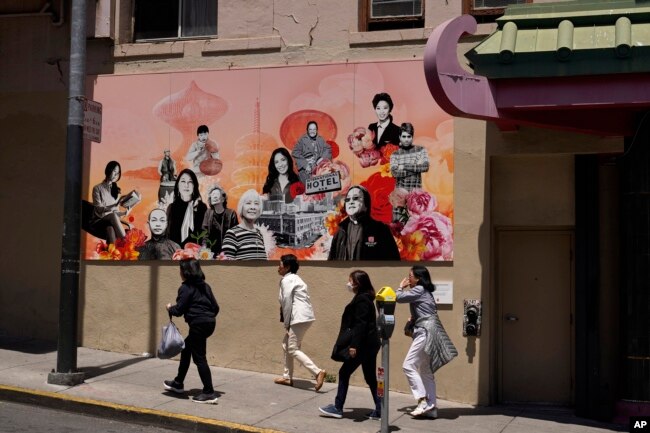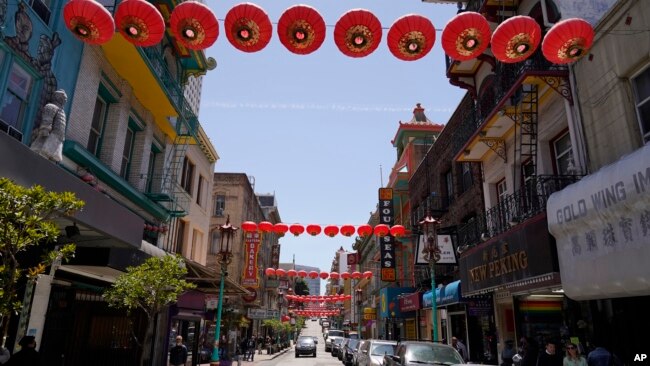チャイナタウン
”Anti-Asian " この一言が表すものはなんでしょうか?
中国人、韓国人、台湾人そして日本人は外国人からは区別がつかないでしょう。私たちも自身もです。言葉を発しなければ、隣の座席の人が持つパスポートでしか判断できません。
情報統制されている国民の海外進出には、少なからずなんらかの違和感を覚えますが、一括りにされると悲しくなるのはどの国の人も同じでしょう!!
皆アイデンティティーを持っているからです。
VOAで英語を学びましょう!!
パンデミック、反アジアの暴力を乗り越え、チャイナタウンが帰ってきた(和訳)
Chinatown Returns after Pandemic, Anti-Asian Violence
June 04,2022
チャイナタウンとは、中国本土以外の都市にある、多くの中国人が住む地域のことです。
北米のチャイナタウンでは、文化・芸術団体が長年にわたり、こうしたコミュニティへの関心を高めるための活動を続けてきました。しかし、アジア系コミュニティは最近、パンデミックによる閉鎖とアジア人に対する人種差別的な攻撃の増加という2つの大きな問題に直面しています。
しかし、チャイナタウンがコミュニティや文化の場として復活するためには、そうした辛い経験も重要なのです。
また、都市や企業、中国系コミュニティ以外の若いアジア人からのビジネスやイベントへの関心も高まっています。ウェルズ・ファーゴ銀行は最近、チャイナタウンメディア&アートコラボレーションと協力して、サンフランシスコの壁画”ヒーローズ”を制作しました。この壁画には、地元コミュニティにとって重要な12人のアジア系アメリカ人と太平洋諸島出身者が描かれています。
サンフランシスコ中国文化センターのエグゼクティブ・ディレクター、ジェニー・レオン氏は、”反アジアの憎悪に対処し、アジア系アメリカ人の声を高揚させたい”というのが皆の願いだったと言います。
「チャイナタウンの見え方は、観光客向けの一種のアトラクションやファンタジーとして持ち込まれたものです。」とレオン氏は言います。「それは決してコミュニティの視点や声を称えるためのものではありません。」
ニューヨークのチャイナタウンでは、来月から5つのサマーナイトマーケットの第一弾が始まります。これは Think!Chinatownにとってこれまでで最大のイベントとなります。5年前にオープンしたこの非営利団体は、これまでアーティスト・イン・レジデンス・プログラムやオーラル・ヒストリーのようなプロジェクトを手がけてきました。しかし、”私たちはただ一緒にいる必要がある”という集団的な感覚がある、とThink!Chinatownのディレクターであるイン・コン氏は言います。
ブリティッシュコロンビア州バンクーバーのチャイナタウンでは、パンデミックにより、破壊行為や落書きなどの犯罪の継続的な問題が悪化しています。しかし、昨年中に、COVID-19以前に計画されていた文化プロジェクトを開始することができました。
先月は、チャイナタウン壁画プロジェクトが地元のアーティストによって描かれた数枚の壁画を展示しました。11月には、チャイナタウン・ストーリーテリング・センターがオープンしました。
このセンターを管理するバンクーバー・チャイナタウン財団の代表、キャロル・リー氏は、「(パンデミックに関係なく)いずれにせよ、私たちはこれを行ったでしょう。」と話します。「でもね、ある意味、より必要なことだから、より目的があるように感じられるのです。」
チャイナタウンは全米で50ヶ所弱ありますが、中にはもっと活発なところもあります。チャイナタウンの多くは、19世紀に中国人労働者が流入してできたものです。労働者たちは、他の場所では差別されていたため、そこに住むことが多かったのです。
労働者たちは、台所やバスルームを共有するシングル・ルーム・ハウジング、SROs、に住んでいたと、ハーベイ・ドン氏は言います。彼はカリフォルニア大学バークレー校の民族学とアジア系アメリカ人研究の教授です。チャイナタウンに住む多くの中国系アメリカ人や移民は、今でもそのようなユニットに住んでいます。
また、チャイナタウンでは多くの開発が行われてきました。例えば、サンフランシスコではSROsが売却され、シアトルでは鉄道路線の拡張によりチャイナタウンが縮小されました。他の場所のチャイナタウンも、ジェントリフィケーションのために非常に小さくなったり、消滅してしまったりしています。Gentrificationジェントリフィケーションとは、富裕層にとってより魅力的な場所にすることで、その場所を変えていくことです。
しかし、芸術や文化の支援者たちは、チャイナタウンのプロジェクトを進め続けています。
サンフランシスコのChinatown Media & Arts Collaborativeは、2650万ドルをかけて、2025年にオープン予定のメディア・アートセンターEdge on the Squareの設計を進めています。ニューヨークでは、Think!Chinatownが、アートショーや料理教室のためのキッチン付きスペースの開設を計画しています。
チャイナタウンの内外でアジア系アメリカ人のつながりを維持することが目的です。
「チャイナタウンに集まる理由は、文化的なつながりです。」とコン氏は言います。「それはチャイナタウンの魂です。そして、私たちはそれを守り続け、成長させる必要があるのです。」
Chinatown Returns after Pandemic, Anti-Asian Violence
Chinatowns are areas in cities outside of mainland China that are home to large numbers of Chinese people.
Cultural and arts organizations in Chinatowns across North America have worked for years to bring greater awareness to these communities. But Asian communities have recently faced two major problems –pandemic-related shutdowns and a rise in racist anti-Asian attacks.
But those painful experiences are important to the return of Chinatowns as places of community and culture.
There has also been an increased interest in business and events from cities, companies and younger Asians from outside the Chinese community. Wells Fargo Bank recently partnered with the Chinatown Media & Arts Collaborative on the “heroes” mural in San Francisco, which includes 12 Asian American and Pacific Islanders important to the local community.
Everyone wanted to “really address anti-Asian hate and to uplift Asian American voices,” said Jenny Leung, executive director of the Chinese Culture Center of San Francisco.
“The way that Chinatown looks is imported as a tourist kind of attraction and fantasy for visitors to see,” Leung said. “It’s never really about celebrating the community’s perspective and voice.”
In New York, the first of five summer night markets start next month in the city’s Chinatown. It will be the biggest event so far for Think!Chinatown. The nonprofit group, which opened five years ago, has done projects like artists-in-residency programs and oral histories. But there was a collective feeling of “we just need to be together,” said Yin Kong, director of Think!Chinatown.
In the Chinatown of Vancouver, British Columbia, the pandemic worsened ongoing problems of vandalism, graffiti and other crimes. But within the last year, the city was able to start cultural projects planned before COVID-19.
Last month, the Chinatown Mural Project displayed several murals painted by a local artist. In November, the Chinatown Storytelling Centre opened.
“We would have done this anyway (regardless of the pandemic),” said Carol Lee, head of the Vancouver Chinatown Foundation, which oversees the Centre. “But you know, in some ways, it makes you feel like you have more purpose because it’s more necessary.”
There are fewer than 50 Chinatowns across the U.S. Some are more active than others. Many Chinatowns were created in the 19th century as Chinese workers arrived. The workers often lived there because of discrimination in other places.
The workers lived in single-room-housing units, or SROs, with shared kitchens and bathrooms, said Harvey Dong. He is a professor in ethnic studies and Asian American studies at the University of California, Berkeley. Many older Chinese Americans and immigrants in Chinatown still live in those units.
There has also been a lot of development in Chinatowns. For example, SROs have been sold in San Francisco and a train line expansion has shrunk the Chinatown in Seattle. Chinatowns in other places are now very small or have disappeared because of gentrification. Gentrification is the process of changing a place by making it more appealing to wealthier people.
But arts and culture supporters continue to move forward on projects in Chinatowns.
Chinatown Media & Arts Collaborative in San Francisco is designing Edge on the Square, a $26.5-million media and arts center that is set to open in 2025. In New York, Think!Chinatown plans to open a space with a kitchen for art shows and cooking classes.
The hope is to keep Asian Americans inside and outside of Chinatown connected.
"What draws them to Chinatown is that cultural connection," Kong said. “(It’s) really the soul of Chinatown. And we need to keep protecting it and make sure it can grow.”
Words in This Story
awareness — n. knowledge and awareness of your own personality or character
mural —n. a usually large painting that is done directly on the surface of a wall
tourist — n. a person who travels to a place for pleasure
fantasy — n. something that is produced by the imagination
perspective — n. a way of thinking about and understanding something
residency — n. the state or fact of living in a place
vandalism — n. the act of deliberately destroying or damaging property
graffiti — n. pictures or words painted or drawn on a wall, building, etc.
display — v. to put something where people can see it
regardless — n. in spite of difficulty, trouble, etc

